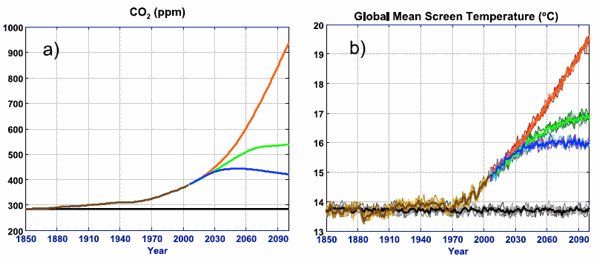Climate science is the foundation of this blog, the sine qua non for all the other analyses.
The reasons we must be far more ambitious in politics and policy and clean technology deployment are the increasing evidence of accelerated carbon-cycle feedbacks and the dire warnings from the scientific community about the dangers of unrestricted greenhouse gas emissions (see Lonnie Thompson on why climatologists are speaking out: “Virtually all of us are now convinced that global warming poses a clear and present danger to civilization”).
Yet, most new climate science remains either under-reported or mis-reported by most of the traditional media and blogosphere. And, like CO2 concentrations, the rate of growth (of important science articles) is growing faster as the reality of human-caused climate changes grows — and it’s growing faster than ClimateProgress can cover thoroughly. At the same time, climate politics and the disinformers and media miscoverage and clean energy solutions and nuclear power and natural gas and peak oil and on and on … also demand attention.
What to do? Well, I hope to be hiring someone soon to help cover some of these issues. Also, I have a plan to expand coverage of climate science.
First, I will still do detailed analysis of the really important studies, like these:
- JPL bombshell: Polar ice sheet mass loss is speeding up, on pace for 1 foot sea level rise by 2050
- NSIDC bombshell: Thawing permafrost feedback will turn Arctic from carbon sink to source in the 2020s, releasing 100 billion tons of carbon by 2100
- Two seminal Nature papers join growing body of evidence that human emissions fuel extreme weather, flooding that harm humans and the environment
- Science: Second ‘100-year’ Amazon drought in 5 years caused huge CO2 emissions. If this pattern continues, the forest would become a warming source.
- Must-read Hansen and Sato paper: We are at a climate tipping point that, once crossed, enables multi-meter sea level rise this century
Second, I will keep covering the important ’second-tier’ studies that deserve attention:
Third, I’ll keep setting the record on the studies that the media doesn’t get quite right:
- NOAA: Monster crop-destroying Russian heat wave to be once-in-a-decade event by 2060s (or sooner)
- Polar bear, Arctic sea ice all-but doomed: Misleading Nature cover story misleads the media, public
Fourth, I’ll repost pieces from Skeptical Science and Dr. Jeff Masters and others from time to time:
- The Physical Chemistry of Carbon Dioxide Absorption
- Was the 2010 Haiti Earthquake triggered by deforestation and the 2008 hurricanes?
Fifth, I’m going to start doing shorter posts on some studies that just capture the essence of the conclusions. This is the tough one for me. Usually, when I see an interesting study I stick the link in a draft post, hoping to come back when I have time to do a full discussion. I do that in every area, of course, and so I now have more than a thousand draft posts that will never get written. There is always something more pressing to work on.
There are a good half dozen scientific studies from just this year that I’d been planning to write more on, but the net result is I haven’t written anything on them. So I’m going to try to fix that with some shorter posts.
I had intended to post an example of this, but, naturally, decided I had more to say on that particular study — and then another more pressing one came up — so it won’t appear until Monday or Tuesday.
Sixth, I’ll choose among the best of the studies that Climate Central is doing mini-summaries on in its new weekly roundup. In its, “Weekly Climate Science Roundup: March 8-14,” CC highlights:
Paper Title: Carbon emission limits required to satisfy future representative concentration pathways of greenhouse gases
Journal:
Geophysical Research Letters
Authors: V. K. Arora, and seven others.The Gist: One of the challenges involved with predicting climate change is that some of the CO2 we put in the atmosphere is removed by natural processes — it is absorbed by the ocean and biosphere — but these natural processes themselves will change as the temperature warms. This paper presents the results from a model that combines a climate model with a model of how the biosphere and oceans absorb CO2. The study finds that it may be nearly impossible to avoid 2°Celsius of warming (the stated goal of the Copenhagen Accord) without drastic emissions cuts in the near future.
This is a classic example of a study I would like to write more about.
The authors focus on the 2C target in their abstract, “The results of this study suggest that limiting warming to roughly 2°C by the end of this century is unlikely since it requires an immediate ramp down of emissions followed by ongoing carbon sequestration in the second half of this century.” That is a “duh” conclusion for CP readers, but still important. Stabilizing at 2C is tough.
The study also appears to show that the ocean and land sinks saturate in the higher emissions scenarios (higher representative concentration pathways or RCPs), which is to say the ocean and land don’t take out of the air the same fraction of human-emitted CO2 as emissions go way up.
Here is the key chart:
“(a) CO2 concentrations used for the control, historical and the three future RCP‐based simulations. (b) Simulated globally‐averaged screen (2m) temperature.”
Note that in the 900 ppm scenario, temperature rises 4.9°C over the 2006 to 2100 time period, which is to say well over 5.5°C from preindustrial levels — and are poised to just keep rising. This isn’t a big surprise, but it still shows again how catastrophic it would be not to get on a stabilization path quickly (see Science stunner: On our current emissions path, CO2 levels in 2100 will hit levels last seen when the Earth was 29°F (16°C) hotter).
Then again, this study appears to ignore many of the major carbon-cycle feedbacks, most notably the defrosting of the tundra. In fact, a much lower emissions scenario is likely to achieve roughly the same warming by 2100 than this study models.
Here’s another study:
Paper Title: Impact of plug-in hybrid electric vehicles on power systems with demand response and wind power
Journal: Energy Policy
Authors: Jianhui Wang, Cong Liu, Dan Ton, Yan Zhou, Jinho Kim, and Anantray Vyas.The Gist: This paper analyzes how “smart charging” can allow wind power to cheaply power plug-in hybrid vehicles. (A plug-in hybrid is a vehicle that runs mostly on battery power, but also has a gas motor for longer trips). One problem with wind power is that, at the height of the wind turbines, the wind is often weakest in the middle of the day and strongest at night. However, people use more electricity during the day than they do in the middle of the night. This mismatch might change with the wider adoption of electric cars — most electric cars would be charged at night, thus using the excess electricity produced by wind power. However, because the wind varies, and because it doesn’t take all night to charge a car, it would be useful for the cars to be flexible in when they are charged. That is, a “smart grid” could help decide when to deliver current to the cars’ batteries, and such an electric grid could charge cars more cheaply. The paper models a possible situation in Illinois in the year 2020, when the authors estimate that about 10 percent of the vehicles will be plug-in hybrids. The authors find the cost of charging all the state’s plug-in hybrids in 2020 could be reduced from about $4 million to $3.5 million per week if such a smart grid is used.
It’s been understood for a long time that the ideal charging system is one in which utilities basically control when most of the charging is done, presumably at a significantly discounted cost, and then there is an extra cost if you want to override that control system and charge, say, during peak times. Good to see a numerical analysis on this topic.
And here’s another interesting study from CC’s previous weekly roundup:
Paper Title: Does increasing energy or electricity consumption improve quality of life in industrial nations?
Journal: Energy Policy
Author: Allan Mazu
The Gist: It’s fairly clear that people in developing countries are better off when they use more energy. Electric lighting, mechanization, and transportation improve lives. But what about in developed countries, where energy use is already very high? Are people’s lives improved by using more energy? This study looks at increases in per capita energy use since 1980 in developed countries and measures how this increase has correlated with well-being. Well-being is measured by a basket of 13 indicators, which range from per capita gross domestic product (GDP) to the societal divorce rate. Of course, any measure of quality of life is highly subjective. Nonetheless, the author finds that in developed countries, increases in energy use do not correlate with increases in well-being.
The study’s conclusion includes electricity: “The present analysis with longitudinal data shows that among industrial nations, increases in per capita energy and electricity consumption over the past three decades are not associated with corresponding improvements in quality of life.”
Again, not a big surprise. After all, California kept per capita electricity consumption flat for the past three decades while it has gone up 60% in the rest of America, and they are in the same country.&n
bsp; Sort of.



